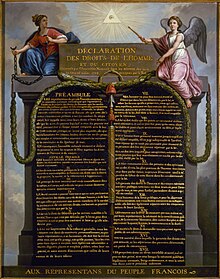
Back Erklärung der Menschen- und Bürgerrechte ALS إعلان حقوق الإنسان والمواطن Arabic اعلان حقوق الانسان والمواطن ARZ Declaración de los Derechos del Home y del Ciudadanu AST İnsan və vətəndaş hüquqları bəyannaməsi Azerbaijani Дэкларацыя правоў чалавека і грамадзяніна Byelorussian Декларация за правата на човека и гражданина Bulgarian Disklêriadur Gwirioù Mab-den hag ar c'heodedour Breton Deklaracija o pravima čovjeka i građanina BS Declaració dels Drets de l'Home i del Ciutadà Catalan

The Declaration of the Rights of Man and of the Citizen (French: Déclaration des droits de l'Homme et du citoyen de 1789), set by France's National Constituent Assembly in 1789, is a human civil rights document from the French Revolution.[1] Inspired by Enlightenment philosophers, the Declaration was a core statement of the values of the French Revolution and had a significant impact on the development of popular conceptions of individual liberty and democracy in Europe and worldwide.[2]
The Declaration was initially drafted by Marquis de Lafayette, with assistance from Thomas Jefferson, but the majority of the final draft came from Abbé Sieyès.[3] Influenced by the doctrine of natural right, human rights are held to be universal: valid at all times and in every place. It became the basis for a nation of free individuals protected equally by the law. It is included at the beginning of the constitutions of both the Fourth French Republic (1946) and Fifth Republic (1958), and is considered valid as constitutional law.
- ^ The French title can also be translated in the modern era as "Declaration of Human and Civic Rights".
- ^ Kopstein Kopstein (2000). Comparative Politics: Interests, Identities, and Institutions in a Changing Global Order. Cambridge UP. p. 72. ISBN 978-0521633567.
- ^ Fremont-Barnes 2007, p. 190.
© MMXXIII Rich X Search. We shall prevail. All rights reserved. Rich X Search